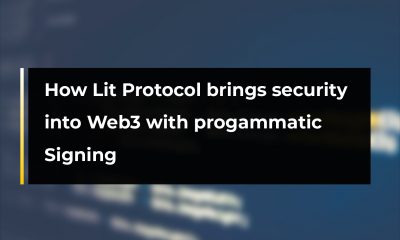FEATURED
Why Web3 developers need TLSNotary

At EthGlobal, the audience was enlightened by the presentation of Hendrik Eeckhaut, computer scientist and Project Lead, Ethereum Foundation, on the promising opportunities offered by TLSNotary for effective data management.
The Ethereum Foundation, a non-profit organization committed to advancing Ethereum and its associated technologies, takes on the crucial role of nurturing the Ethereum protocol and community.
By funding protocol development, fostering ecosystem growth, and staunchly advocating for Ethereum, the Foundation forms a vital component within the expansive Ethereum ecosystem.
Understanding TLSNotary
According to Hendrik, TLSNotary offers a transformative approach to integrating private data into hackathon projects and web applications. Its primary goal is to make private data on web servers portable, putting control in the hands of users.
He said that this newfound data portability allows users to manage how their data is utilized, ensuring trustworthiness for third-party applications.
Why TLSNotary
The speaker added that in the current web landscape, TLS plays a crucial role in ensuring data authenticity between users and servers.
However, it falls short when it comes to data sharing among users and verifying user modifications
That’s where TLSNotary comes in. It introduces a privacy-focused approach to data authentication by utilizing reliable notarization.
Notarization involves the verification and validation of data, transactions, or information by a trusted third party or decentralized network.
Through this verification process, the authenticity and integrity of the data are ensured, making it ideal for secure data sharing and fostering trust in decentralized systems.
MPC, selective disclosure, and trust assumptions
Additionally, he noted that TLSNotary employs Multi-Party Computation (MPC) to ensure data authenticity without revealing the data’s actual contents.
MPC is a cryptographic technique that enables multiple parties to jointly compute a function over their inputs while keeping those inputs private.
This process allows parties to collaborate on computations without revealing their raw data to each other, enhancing privacy and security in various applications.
The Project Lead added that selective disclosure is another remarkable feature of TLSNotary. It allows users to redact specific information before sharing.
This means users can choose which parts of the data they want to reveal to others, enhancing privacy and security.
Additionally, TLSNotary minimizes trust assumptions. The server is unaware of the notarization process, and TLSNotary is open-source, allowing users to verify its cryptographic implementation. Therefore, data remains secure, and no information is leaked to the notary.
Potential use cases
The presentation also explored various potential use cases for TLSNotary such as distributed web applications where users can post independent reviews for products, providing proof of purchase without revealing private information.
TLSNotary can also be deployed in creating web applications for users to upload private messages, enabling them to prove the authenticity of their messages without disclosing their content.
Additional applications include employing TLSNotary to provide evidence of censorship instances across online platforms, verifying ownership of digital assets, importing web2 reputations to unlock access to particular chat rooms, and using it as a proof dispenser to incentivize user participation in events and activities.
Read also; Fuel Labs: the importance of Predicates and Multisigs
























